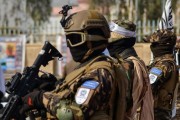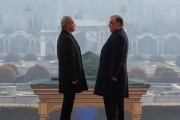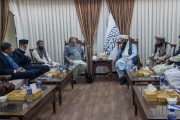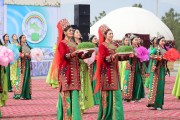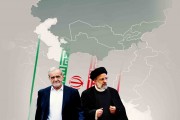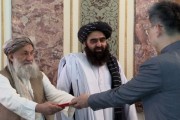Publish Date
Wednesday 22 February 2023 - 09:57
recommended
0
Taliban and State- Building: advantages and disadvantages
Afghanistan never got the opportunity to build a state. In the 100-year history of this country, the process of becoming a nation-state was interrupted many times. Although the Taliban did not get the necessary opportunity to build a government in the first round of its rule, in the second round it has many possibilities to build a government with modern political and administrative structures. In the state-building process, the Taliban is trying to maintain the administrative structures of the modern government that it has inherited, but it basically pays less attention to the structuring of its system, which will definitely cause many problems for the Taliban government in the long term.
By: Mir Ahmad Mashal
Introduction
From the beginning of the 20th century, Afghanistan stepped into the arena of being a modern state and went through unsuccessful and incomplete experiences of state building. It seems that the most important reason for not establishing a stable government in Afghanistan was the agents of the Afghan government. For example, at the beginning of the 20th century, Amanullah Khan tried to build a modern government in Afghanistan by imitating Western structures, but he failed. Then, a few decades later, the communists tried to imitate the communist system, which also led to its collapse. At the beginning of the 21st century, a modern government was formed in Afghanistan, which faced the fate of previous governments due to the crushing blows of the Taliban.
Now that the Taliban are in the position of a state-building force, several questions are raised, such as what will be the state-building process of this group? What are the strengths and weaknesses of a state that is in the thinking and actions of the Taliban? To what extent will they be able to move Afghanistan in the right direction of sustainable state-building? Before answering these questions, it is appropriate to explain the meaning of “state”, and take a look at the history of state-building in Afghanistan.
What does “state” mean?
The state is one of the phenomena that there is no consensus on its definition. This phenomenon is worth investigating for two reasons. First, it deals with power, and in this respect, it has a higher position in political philosophy than any other social phenomenon. Second, the concept of state is usually close to the concept of governance, and there is almost a kind of synonymy between them. Among the multitude of definitions that exist about the concept of state, a rather eloquent definition was given by the German philosopher Max Weber. According to Weber, "the state is a human community that successfully claims the monopoly of the legitimate use of force or violence within a given territory." Anthony Giddens also gave a comprehensive definition of the state and says that the state is the political apparatus of the governance, including institutions such as the House of Representatives or Congress, as well as the officials and employees of the civil administrations that govern a territory. According to him, the state’s authority is provided by the support of the legal system, and the ability to use military force to implement its policies.
Although there have been many discussions about the concept of state throughout history, Andrew Haywood believes that today the state practically overshadows almost all people's activities. The government regulates, monitors, authorizes or prohibits everything. From education to economic management, from social welfare to public health, and from domestic policies to foreign defense, the government shapes and controls everything. Indicatively, today's modern governments have these components: legitimate monopoly to control the means of violence; a specific territory; sovereignty; centralized power, codified constitution; impersonal use of power; nationalism; public bureaucracy; authority, or legitimacy; existence of citizenship rights for people; and the existence of a legal tax network.
History of state- building in Afghanistan
Most researchers believe that the history of state- building in Afghanistan goes back to the reign of Ahmad Shah Abdali. Even if Abdali cannot be considered the founder of the modern state in Afghanistan, he was definitely the founder of a state that ultimately led to the creation of modern governance structures in Afghanistan.
After the death of Nadir Shah, Ahmad Shah Abdali established a new dynasty in Kandahar. Inspired by previous governments, especially Afsharia, he created a government system and its related structures in Afghanistan. At the level of government, court and provinces, he created a large set of institutions and offices, including the supreme court, treasury, registry office, transportation office, sharia courts, as well as jirgas consisting of chiefs of large tribes and high-ranking officers and agents (These jirgas held meetings in the capital from time to time, and advised the king on military and political issues.)
The next prominent stage in the state-building process in Afghanistan is the reign of Amir Shir Ali Khan. After the establishment of his monarchy in 1868, Shir Ali Khan undertook many reform programs at different levels of the Afghan government, including the formation of an executive branch composed of several ministers, the establishment of a 12-member governmental council, reforms and modernization of the education sector and creation of two modern schools (one military and the other civilian), reform and development of economic affairs, reforms in military affairs, and establishing new military rules and frameworks.
Another stage that brought Afghanistan more into the modern arena of state building was the Amani era. With his ambitious initiatives, especially the modernization of Afghanistan by following western models, Amanullah Khan made a great but unsuccessful effort to modernize the entire structure of Afghan society, including state-building. Although Amanullah himself was soon sidelined and his reform and modernization programs were stopped, his actions could influence the state-building process in Afghanistan in the following periods, which manifested itself in a way during the Zahir Shah period.
With the rise of communists, the evolution of the state-building process in Afghanistan took a different but bloody path, which eventually led to the complete collapse of the government system in Afghanistan at the beginning of the 1990s. As a result, Afghanistan was literally deprived of a government for a decade. During this period, when the civil war for power between Jihadi groups took place, the framework of the system and the government completely fell apart until the events of September 11, 2001. At this time, the United States and its allies invaded Afghanistan and established a new government in Afghanistan. This new westernized government under the name of the Islamic Republic, which was supported by a modern and developed constitution, was always developing with the help of Western intellectual and financial resources during its 20-year life.
Although the legal basis and the political and executive structures of the Islamic Republic of Afghanistan were somewhat developed and complete, two basic factors led it to the destruction path: the first factor was the opposition of the Taliban against it; and the second factor was the internal power struggle in the government, or Its incongruous combination in the agency dimension.
The incongruous composition of the agency means that the structures and institutions of the Islamic Republic were filled by people who were all in opposition to each other. For example, in the national unity government, power was divided into two separate structures, the presidency and the executive presidency, and these two structures were always in a state of conflict due to the horizontal division of power between them. This led to a decrease in the positive function of the whole system. Therefore, the government of the Islamic Republic, despite having the democratic legal support as well as structural and institutional expansion, and receiving a lot of external financial aid, could not maintain itself and finally collapsed. For example, in the National Unity Government (NUG), power was divided into two separate structures - the president and the chief executive - and these two structures were always in a state of conflict due to the horizontal division of power between them. This led to a decrease in the positive function of the whole system. Therefore, the government of the Islamic Republic, despite having the democratic legal support as well as structural and institutional expansion, and receiving a lot of external financial aid, could not maintain itself, and finally collapsed.
Taliban and the state- building process
The Talaban rule can be divided into two separate historical periods: The first period, in the second half of the 1990s; and the second period, after 2021.
First government
In the first period of their rule, the Taliban had one advantage, and at the same time, they were struggling with three problems. The advantage of the Taliban in the first period was that it emerged when Afghanistan was in a full-scale civil war and absolute internal chaos. In such an environment where the system and the government had fallen apart, the Taliban, without any previous experience of even managing a small neighborhood, suddenly dominated almost the whole of Afghanistan as agents of the government. Although the consolidation of order and security was their privilege, they also faced three major problems: lack of government structures due to their collapse; war with an active and powerful opposing front; and being under the pressure of global sanctions and isolation. Although the events of September 11 did not allow the Taliban to show how they want to overcome those problems, the structure of their system and the type of their government in those five years did not get a chance to become legal and structured. Therefore, they continued to follow their own basic principles until they were overthrown by the United States.
Second government
Compared to the previous round, the Taliban now have two advantages, and face only one problem. In the current period, the Taliban have acquired a government that has been built over a period of twenty years with billions of dollars of external resources. Capturing this government with the least amount of damage to its body and structure is one of the great benefits that the Taliban received during this period. Another privilege of the Taliban is that currently, except for a very small minority, there is no real powerful force in front of them. The only major problem that the Taliban is facing is some of their inconsistent policies with human rights issues such as suspending the right of work and education for girls and women. This problem, which originates from the Taliban's internal policy, in addition to provoking silent internal protests, has also caused the anger of the international community, and caused the Taliban government to not be officially recognized by the world.
If we ignore this problem, or if we assume that this issue will be resolved in the near future in favor of women's work and education, then the question is, what will be the process of state-building by the Taliban? And what strengths and weaknesses can be seen in the approaches of the Taliban in this regard?
Taliban’s advantages in state-building process
As mentioned earlier, the Taliban inherited a state that had a complete political structure and large executive institutions. To put it more clearly, the Taliban seized the government with a large and active organization, and only bothered to sit on the prepared seats of the ministries and directorates. In this section, we will examine the strengths of the Taliban in the process of governance and state-building.
Having the ability to create nationwide public order
One of the capabilities of the Taliban, which cannot be found in any other group or force in Afghanistan, is the ability to create a nationwide public order. During its sixteen months of dominance, the Taliban showed that it can provide its desired public order over the entire geography of Afghanistan. Afghanistan is a country where ethnic populations are concentrated in every part of it. For example, Tajiks are mainly settled in the northern and northeastern regions, Uzbeks in the northern regions, Hazaras in the central regions, and Pashtuns in the southern and eastern regions. It is quite difficult to manage such dense ethnic populations in any part of Afghanistan, especially when weapons are available to all. However, regardless of which ethnic group they belong to, the Taliban are capable of controlling all areas of the country and establishing public order throughout the country as government agents. Maintaining such order and its continuation in the long term can strengthen the foundations of the government in the center, and guarantee its durability.
Trying to maintain the executive bodies of the gove
rnment
Since the Taliban dominated the government in Afghanistan, many efforts have been made to preserve the executive bodies of the government that were formed in the past and, if possible, to expand them even more. In order to improve the functioning of some government institutions and increase the quality of work, the Taliban has also carried out structural and organizational reforms and has separated or merged several government institutions in the past year. For example, the Taliban separated the Ministry of Labor, Social Affairs, Martyrs and the Disabled into two separate ministries; or dissolved some institutions such as the Organization of Local Governance, and reassigned provincial affairs to the Ministry of Interior. Although the Taliban's efforts are aimed at strengthening the central power or military centralization, there is a defensible logic for such an approach: in this way, the centrifugal forces that have been strongly strengthened in Afghanistan over the past few decades and have the potential to overthrow the system, will have less opportunity to develop and be active.
Trying to maintain the modern bureaucratic system of the previous government
One of the areas in which the government in Afghanistan had a relatively good development in the last twenty years was the expansion of bureaucratic system, and stabilization of the hierarchical order in government offices. Although this growth was accompanied by the expansion of administrative corruption, but if we consider this corruption as an incidental aspect - not its intrinsic aspect- then the development of the administrative system (especially the development of electronic government, which has grown significantly in the past few years) is an undeniable fact. Although the Taliban appointed non-professionals, generally mullahs, at the head of most offices, they still kept the previous experienced people in the lower levels of the administrative hierarchy. Therefore, we can see that after sixteen months, there is not much stagnation in the provision of government services.
Collection of income tax and customs duties
Another significant issue that has even attracted the admiration of the West is the positive performance of the Taliban government in collecting taxes and customs revenues in the country. Since coming to power, the Taliban has increased the direct supervision of customs revenues. They managed to de-corrupt the customs system, and transparently transfer its revenues to the government treasury. Along with that, the Taliban started collecting income tax, from the low levels of small trades and guilds to large businesses, in a regular and systematic manner. This money is collected in urban areas in the form of tax, and in rural areas in the form of zakat by representatives of local administrations. In this regard, the Taliban was even able to collect the taxes that had not been paid over the years. Despite the fact that the Taliban's tax measures have brought some protests, and in some cases, created a double burden for taxpayers, but since one of the main sources of government spending is tax, the Taliban follows this program seriously.
Taliban’s disadvantages in state-building process
So far, it is concluded that whatever the Taliban has done in line with the government process is to maintain the executive structures and government institutions that were built and paid for in the previous regime. Of course, it cannot be said that carrying out these efforts means that the foundations of the government have been consolidated. As it was said before, the Taliban managed to maintain the organizations and the administrative structure of the government during their rule, and this may be their only goal for the next few years. However, this group has not yet taken significant measures in order to create political structures that can strengthen the legal and political basis of the system.
In the following section, some of the weaknesses of the Taliban are mentioned. These weaknesses show that the Taliban do not pay attention to the issue of establishing the foundations of the system through legal and political basis.
Not specifying the type of system
Every system in modern government systems relies on the foundations on which the sustainability of the system is based. Today's common systems in the world - apart from a few systems of hereditary monarchy - mostly have frameworks on which a government is based. If we don't go to more distant countries, most of the countries in Afghanistan's neighborhood have republic systems that are defined by the constitution, and have contributed to their current consistency and future sustainability. Meanwhile, the Taliban has not yet been able to determine the type of its system. What has been heard from the Taliban so far about the system is "Islamic Emirate". However, there has been no talk about what kind of legal frameworks the Islamic Emirate is defined on, and based on what principled and regular mechanism it will guarantee its existing consistency and sustainability in the future. Therefore, one of the major weaknesses of the Taliban state-building process is the lack of basic and legal frameworks for the government structure which is known as the Islamic Emirate.
Centralized power and lack of a system for separation of powers
Another important issue that today puts governments in a state of balance in terms of internal power distribution is the existence of a system for the separation of powers which is determined by the constitution. But this system is not defined at all in the Islamic Emirate, and practically does not exist in it. What is observed in the Islamic Emirate is the concentration of power in the hands of one person named Amir al-Mu'minin (Commander of the Faithful), who has no systematic framework for his authority. Amir al-Mu'minin, who is entrusted with unlimited power through the pledge of allegiance, is in a position that obliges everyone to follow him. There is not even a council to monitor the performance of Amir al-Mu'minin, and he is only disobeyed when he does not follow the principles of Sharia.
The danger that such a situation creates is that any kind of political mistake of the Amir does not make others lose their allegiance to him. It is obligatory for everyone to follow Amir as long as he does not deviate from Sharia. The emir's Emirate is for life, except in cases such as committing illegal acts, confusion in such a way that it becomes impossible for him to manage affairs, resignation at his own request, or his death. Therefore, one of the weak points of the Taliban state-building is the vertical concentration of power, and the unlimited and unframed power of the country's leader. One of the biggest problems of this issue is not being accountable to the nation. Meanwhile, there is also a Council of Ministers and a Prime Minister, whose duty is only to implement the emir's orders and carry out government executive affairs, and they do not have any decision-making authority.
Shariaism instead of legality
The rule of Islam is an undeniable issue in the Afghan society. But in the past systems, Sharia was embedded in the framework of codified laws, and of course it was modified in some cases. The Islamic Emirate of the Taliban, both in the first round and now, unilaterally emphasizes the implementation of Sharia law. This issue can be attractive in the religious society of Afghanistan. But if we consider that the evolution of states depends on the existence of codified laws, this Shariatism will be a disruptive issue for state-building. For example, in today's global environment, if the implementation of Hudud punishments (which is a part of Shariatism) is carried out in classical ways, it will lead to negative propaganda towards both Islam and the government system.
Conclusion
Afghanistan is one of the rare countries in the world that never got the necessary opportunity to build a state. During its one-hundred-year history, this country started the process of becoming a nation-state, it has been interrupted many times and has had to start all over again. With the establishment of the Taliban in this country after the collapse of the Islamic Republic, it was thought that once again everything in this country should start anew. Although the Taliban did not get the necessary opportunity to build a state in the first period of its rule, in this period, it has had the opportunity to build a state with modern political and administrative structures. What the Taliban is doing now in the state-building process is following two almost different paths. In the first path, they are trying to maintain the administrative structures of a modern state that they have inherited, and even making efforts to strengthen them. But it has paid less attention to structuring its system in a fundamental and basic way. If the movement in these two directions does not show its damages in the short term, it can definitely involve the Taliban government in many problems and disasters in the long term.
Mir Ahmad Mashal is, a senior expert in international relations
Introduction
From the beginning of the 20th century, Afghanistan stepped into the arena of being a modern state and went through unsuccessful and incomplete experiences of state building. It seems that the most important reason for not establishing a stable government in Afghanistan was the agents of the Afghan government. For example, at the beginning of the 20th century, Amanullah Khan tried to build a modern government in Afghanistan by imitating Western structures, but he failed. Then, a few decades later, the communists tried to imitate the communist system, which also led to its collapse. At the beginning of the 21st century, a modern government was formed in Afghanistan, which faced the fate of previous governments due to the crushing blows of the Taliban.
Now that the Taliban are in the position of a state-building force, several questions are raised, such as what will be the state-building process of this group? What are the strengths and weaknesses of a state that is in the thinking and actions of the Taliban? To what extent will they be able to move Afghanistan in the right direction of sustainable state-building? Before answering these questions, it is appropriate to explain the meaning of “state”, and take a look at the history of state-building in Afghanistan.
What does “state” mean?
The state is one of the phenomena that there is no consensus on its definition. This phenomenon is worth investigating for two reasons. First, it deals with power, and in this respect, it has a higher position in political philosophy than any other social phenomenon. Second, the concept of state is usually close to the concept of governance, and there is almost a kind of synonymy between them. Among the multitude of definitions that exist about the concept of state, a rather eloquent definition was given by the German philosopher Max Weber. According to Weber, "the state is a human community that successfully claims the monopoly of the legitimate use of force or violence within a given territory." Anthony Giddens also gave a comprehensive definition of the state and says that the state is the political apparatus of the governance, including institutions such as the House of Representatives or Congress, as well as the officials and employees of the civil administrations that govern a territory. According to him, the state’s authority is provided by the support of the legal system, and the ability to use military force to implement its policies.
Although there have been many discussions about the concept of state throughout history, Andrew Haywood believes that today the state practically overshadows almost all people's activities. The government regulates, monitors, authorizes or prohibits everything. From education to economic management, from social welfare to public health, and from domestic policies to foreign defense, the government shapes and controls everything. Indicatively, today's modern governments have these components: legitimate monopoly to control the means of violence; a specific territory; sovereignty; centralized power, codified constitution; impersonal use of power; nationalism; public bureaucracy; authority, or legitimacy; existence of citizenship rights for people; and the existence of a legal tax network.
History of state- building in Afghanistan
Most researchers believe that the history of state- building in Afghanistan goes back to the reign of Ahmad Shah Abdali. Even if Abdali cannot be considered the founder of the modern state in Afghanistan, he was definitely the founder of a state that ultimately led to the creation of modern governance structures in Afghanistan.
After the death of Nadir Shah, Ahmad Shah Abdali established a new dynasty in Kandahar. Inspired by previous governments, especially Afsharia, he created a government system and its related structures in Afghanistan. At the level of government, court and provinces, he created a large set of institutions and offices, including the supreme court, treasury, registry office, transportation office, sharia courts, as well as jirgas consisting of chiefs of large tribes and high-ranking officers and agents (These jirgas held meetings in the capital from time to time, and advised the king on military and political issues.)
The next prominent stage in the state-building process in Afghanistan is the reign of Amir Shir Ali Khan. After the establishment of his monarchy in 1868, Shir Ali Khan undertook many reform programs at different levels of the Afghan government, including the formation of an executive branch composed of several ministers, the establishment of a 12-member governmental council, reforms and modernization of the education sector and creation of two modern schools (one military and the other civilian), reform and development of economic affairs, reforms in military affairs, and establishing new military rules and frameworks.
Another stage that brought Afghanistan more into the modern arena of state building was the Amani era. With his ambitious initiatives, especially the modernization of Afghanistan by following western models, Amanullah Khan made a great but unsuccessful effort to modernize the entire structure of Afghan society, including state-building. Although Amanullah himself was soon sidelined and his reform and modernization programs were stopped, his actions could influence the state-building process in Afghanistan in the following periods, which manifested itself in a way during the Zahir Shah period.
With the rise of communists, the evolution of the state-building process in Afghanistan took a different but bloody path, which eventually led to the complete collapse of the government system in Afghanistan at the beginning of the 1990s. As a result, Afghanistan was literally deprived of a government for a decade. During this period, when the civil war for power between Jihadi groups took place, the framework of the system and the government completely fell apart until the events of September 11, 2001. At this time, the United States and its allies invaded Afghanistan and established a new government in Afghanistan. This new westernized government under the name of the Islamic Republic, which was supported by a modern and developed constitution, was always developing with the help of Western intellectual and financial resources during its 20-year life.
Although the legal basis and the political and executive structures of the Islamic Republic of Afghanistan were somewhat developed and complete, two basic factors led it to the destruction path: the first factor was the opposition of the Taliban against it; and the second factor was the internal power struggle in the government, or Its incongruous combination in the agency dimension.
The incongruous composition of the agency means that the structures and institutions of the Islamic Republic were filled by people who were all in opposition to each other. For example, in the national unity government, power was divided into two separate structures, the presidency and the executive presidency, and these two structures were always in a state of conflict due to the horizontal division of power between them. This led to a decrease in the positive function of the whole system. Therefore, the government of the Islamic Republic, despite having the democratic legal support as well as structural and institutional expansion, and receiving a lot of external financial aid, could not maintain itself and finally collapsed. For example, in the National Unity Government (NUG), power was divided into two separate structures - the president and the chief executive - and these two structures were always in a state of conflict due to the horizontal division of power between them. This led to a decrease in the positive function of the whole system. Therefore, the government of the Islamic Republic, despite having the democratic legal support as well as structural and institutional expansion, and receiving a lot of external financial aid, could not maintain itself, and finally collapsed.
Taliban and the state- building process
The Talaban rule can be divided into two separate historical periods: The first period, in the second half of the 1990s; and the second period, after 2021.
First government
In the first period of their rule, the Taliban had one advantage, and at the same time, they were struggling with three problems. The advantage of the Taliban in the first period was that it emerged when Afghanistan was in a full-scale civil war and absolute internal chaos. In such an environment where the system and the government had fallen apart, the Taliban, without any previous experience of even managing a small neighborhood, suddenly dominated almost the whole of Afghanistan as agents of the government. Although the consolidation of order and security was their privilege, they also faced three major problems: lack of government structures due to their collapse; war with an active and powerful opposing front; and being under the pressure of global sanctions and isolation. Although the events of September 11 did not allow the Taliban to show how they want to overcome those problems, the structure of their system and the type of their government in those five years did not get a chance to become legal and structured. Therefore, they continued to follow their own basic principles until they were overthrown by the United States.
Second government
Compared to the previous round, the Taliban now have two advantages, and face only one problem. In the current period, the Taliban have acquired a government that has been built over a period of twenty years with billions of dollars of external resources. Capturing this government with the least amount of damage to its body and structure is one of the great benefits that the Taliban received during this period. Another privilege of the Taliban is that currently, except for a very small minority, there is no real powerful force in front of them. The only major problem that the Taliban is facing is some of their inconsistent policies with human rights issues such as suspending the right of work and education for girls and women. This problem, which originates from the Taliban's internal policy, in addition to provoking silent internal protests, has also caused the anger of the international community, and caused the Taliban government to not be officially recognized by the world.
If we ignore this problem, or if we assume that this issue will be resolved in the near future in favor of women's work and education, then the question is, what will be the process of state-building by the Taliban? And what strengths and weaknesses can be seen in the approaches of the Taliban in this regard?
Taliban’s advantages in state-building process
As mentioned earlier, the Taliban inherited a state that had a complete political structure and large executive institutions. To put it more clearly, the Taliban seized the government with a large and active organization, and only bothered to sit on the prepared seats of the ministries and directorates. In this section, we will examine the strengths of the Taliban in the process of governance and state-building.
Having the ability to create nationwide public order
One of the capabilities of the Taliban, which cannot be found in any other group or force in Afghanistan, is the ability to create a nationwide public order. During its sixteen months of dominance, the Taliban showed that it can provide its desired public order over the entire geography of Afghanistan. Afghanistan is a country where ethnic populations are concentrated in every part of it. For example, Tajiks are mainly settled in the northern and northeastern regions, Uzbeks in the northern regions, Hazaras in the central regions, and Pashtuns in the southern and eastern regions. It is quite difficult to manage such dense ethnic populations in any part of Afghanistan, especially when weapons are available to all. However, regardless of which ethnic group they belong to, the Taliban are capable of controlling all areas of the country and establishing public order throughout the country as government agents. Maintaining such order and its continuation in the long term can strengthen the foundations of the government in the center, and guarantee its durability.
Trying to maintain the executive bodies of the gove
rnment
Since the Taliban dominated the government in Afghanistan, many efforts have been made to preserve the executive bodies of the government that were formed in the past and, if possible, to expand them even more. In order to improve the functioning of some government institutions and increase the quality of work, the Taliban has also carried out structural and organizational reforms and has separated or merged several government institutions in the past year. For example, the Taliban separated the Ministry of Labor, Social Affairs, Martyrs and the Disabled into two separate ministries; or dissolved some institutions such as the Organization of Local Governance, and reassigned provincial affairs to the Ministry of Interior. Although the Taliban's efforts are aimed at strengthening the central power or military centralization, there is a defensible logic for such an approach: in this way, the centrifugal forces that have been strongly strengthened in Afghanistan over the past few decades and have the potential to overthrow the system, will have less opportunity to develop and be active.
Trying to maintain the modern bureaucratic system of the previous government
One of the areas in which the government in Afghanistan had a relatively good development in the last twenty years was the expansion of bureaucratic system, and stabilization of the hierarchical order in government offices. Although this growth was accompanied by the expansion of administrative corruption, but if we consider this corruption as an incidental aspect - not its intrinsic aspect- then the development of the administrative system (especially the development of electronic government, which has grown significantly in the past few years) is an undeniable fact. Although the Taliban appointed non-professionals, generally mullahs, at the head of most offices, they still kept the previous experienced people in the lower levels of the administrative hierarchy. Therefore, we can see that after sixteen months, there is not much stagnation in the provision of government services.
Collection of income tax and customs duties
Another significant issue that has even attracted the admiration of the West is the positive performance of the Taliban government in collecting taxes and customs revenues in the country. Since coming to power, the Taliban has increased the direct supervision of customs revenues. They managed to de-corrupt the customs system, and transparently transfer its revenues to the government treasury. Along with that, the Taliban started collecting income tax, from the low levels of small trades and guilds to large businesses, in a regular and systematic manner. This money is collected in urban areas in the form of tax, and in rural areas in the form of zakat by representatives of local administrations. In this regard, the Taliban was even able to collect the taxes that had not been paid over the years. Despite the fact that the Taliban's tax measures have brought some protests, and in some cases, created a double burden for taxpayers, but since one of the main sources of government spending is tax, the Taliban follows this program seriously.
Taliban’s disadvantages in state-building process
So far, it is concluded that whatever the Taliban has done in line with the government process is to maintain the executive structures and government institutions that were built and paid for in the previous regime. Of course, it cannot be said that carrying out these efforts means that the foundations of the government have been consolidated. As it was said before, the Taliban managed to maintain the organizations and the administrative structure of the government during their rule, and this may be their only goal for the next few years. However, this group has not yet taken significant measures in order to create political structures that can strengthen the legal and political basis of the system.
In the following section, some of the weaknesses of the Taliban are mentioned. These weaknesses show that the Taliban do not pay attention to the issue of establishing the foundations of the system through legal and political basis.
Not specifying the type of system
Every system in modern government systems relies on the foundations on which the sustainability of the system is based. Today's common systems in the world - apart from a few systems of hereditary monarchy - mostly have frameworks on which a government is based. If we don't go to more distant countries, most of the countries in Afghanistan's neighborhood have republic systems that are defined by the constitution, and have contributed to their current consistency and future sustainability. Meanwhile, the Taliban has not yet been able to determine the type of its system. What has been heard from the Taliban so far about the system is "Islamic Emirate". However, there has been no talk about what kind of legal frameworks the Islamic Emirate is defined on, and based on what principled and regular mechanism it will guarantee its existing consistency and sustainability in the future. Therefore, one of the major weaknesses of the Taliban state-building process is the lack of basic and legal frameworks for the government structure which is known as the Islamic Emirate.
Centralized power and lack of a system for separation of powers
Another important issue that today puts governments in a state of balance in terms of internal power distribution is the existence of a system for the separation of powers which is determined by the constitution. But this system is not defined at all in the Islamic Emirate, and practically does not exist in it. What is observed in the Islamic Emirate is the concentration of power in the hands of one person named Amir al-Mu'minin (Commander of the Faithful), who has no systematic framework for his authority. Amir al-Mu'minin, who is entrusted with unlimited power through the pledge of allegiance, is in a position that obliges everyone to follow him. There is not even a council to monitor the performance of Amir al-Mu'minin, and he is only disobeyed when he does not follow the principles of Sharia.
The danger that such a situation creates is that any kind of political mistake of the Amir does not make others lose their allegiance to him. It is obligatory for everyone to follow Amir as long as he does not deviate from Sharia. The emir's Emirate is for life, except in cases such as committing illegal acts, confusion in such a way that it becomes impossible for him to manage affairs, resignation at his own request, or his death. Therefore, one of the weak points of the Taliban state-building is the vertical concentration of power, and the unlimited and unframed power of the country's leader. One of the biggest problems of this issue is not being accountable to the nation. Meanwhile, there is also a Council of Ministers and a Prime Minister, whose duty is only to implement the emir's orders and carry out government executive affairs, and they do not have any decision-making authority.
Shariaism instead of legality
The rule of Islam is an undeniable issue in the Afghan society. But in the past systems, Sharia was embedded in the framework of codified laws, and of course it was modified in some cases. The Islamic Emirate of the Taliban, both in the first round and now, unilaterally emphasizes the implementation of Sharia law. This issue can be attractive in the religious society of Afghanistan. But if we consider that the evolution of states depends on the existence of codified laws, this Shariatism will be a disruptive issue for state-building. For example, in today's global environment, if the implementation of Hudud punishments (which is a part of Shariatism) is carried out in classical ways, it will lead to negative propaganda towards both Islam and the government system.
Conclusion
Afghanistan is one of the rare countries in the world that never got the necessary opportunity to build a state. During its one-hundred-year history, this country started the process of becoming a nation-state, it has been interrupted many times and has had to start all over again. With the establishment of the Taliban in this country after the collapse of the Islamic Republic, it was thought that once again everything in this country should start anew. Although the Taliban did not get the necessary opportunity to build a state in the first period of its rule, in this period, it has had the opportunity to build a state with modern political and administrative structures. What the Taliban is doing now in the state-building process is following two almost different paths. In the first path, they are trying to maintain the administrative structures of a modern state that they have inherited, and even making efforts to strengthen them. But it has paid less attention to structuring its system in a fundamental and basic way. If the movement in these two directions does not show its damages in the short term, it can definitely involve the Taliban government in many problems and disasters in the long term.
Mir Ahmad Mashal is, a senior expert in international relations
News code:3394






